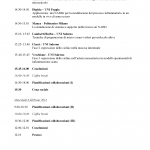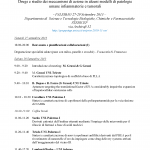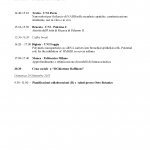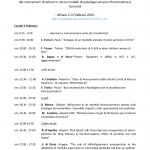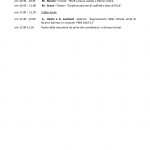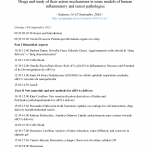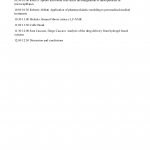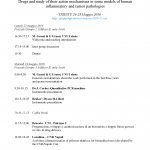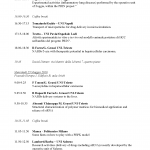|
Title
Identification of optimal delivery systems for the Nucleic Acid Based Drugs and study of the action mechanisms in some models of human tumoral and inflammatory pathologies
Principal Investigator: Mario Grassi
Abstract
For hepatocellular carcinoma, prostate adenocarcinoma, coronary restenosis, abdominal aortic aneurism, inflammatory bowel and lung diseases, a significant improvement in the efficacies of the therapeutic approaches so far available is urgently required. The use of “nucleic acid based drugs” (NABDs), a novel and emergent class of molecules, is considered very promising. However, a limitation in NABD use as drugs depends on the lack of optimal delivery systems able to minimize NABD degradation in the biological fluid and allow the targeting to the diseased tissue.
The aim of this project is to develop novel delivery systems for NABDs, appropriate for the considered human pathologies. Our approach will take into consideration the different problematics related to the engineering field, but also chemical, pharmaceutical and biomedical filed. Nine University groups will take part to the project together with eigtheen other non-University research groups.
Research units
| Unit | Team manager | Activities |
| 01. UNITS | Mario Grassi | Read More
|
| 02. UNISA | Gaetano Lamberti | Read More
|
| 03. UNIPV | Piersandro Pallavicini | Read More
To individuate an efficient therapy for hepatocellular carcinoma we will study the delivery NABDs, developed by Unit 01, by means of nanovectors based on gold asymmetric branched nanoparticles (ABN) and on spherical magnetite nanoparticles (MNP). |
| 04. UNINA | Stefano Guido | Read More
The activity is focused on the study of the interaction between human blood cells, in particular red blood cells, and either vessel walls or micro/nano particles, developed by the other Unit, for NABD delivery. |
| 05. CNR NA | Domenico Larobina | Read More
The aim is to support the other research units involved in the project with appropriate structural information on the gel systems employed in the release of NABD. For this specific purpose, we will adopt both mechanical and spectroscopic techniques. Such characterizations represent a useful support to set up the specific polymeric device able to release NABDs. |
| 06. UNIPA1 | Gennara Cavallaro | Read More
We will produce and characterize NABD delivery systems appropriate for the pathological conditions proposed by Units 01, 02 and 08; in particular we will evaluate:
|
| 07. UNIPA2 | Valerio Brucato | Read More
We will prepare polymeric scaffolds (made of PLLA and/or PLLA/PLA mixtures) pre-angiogenized as from proprietary patent, and will carry out advanced “in vitro” tests on the NABD release. PLLA scaffold, featuring a pseudo-vascular structure, prepared as for the proprietary patent, will be cultured with mixed population of mesenchymal cells (to promote the ECM formation) and tumoral cells (of interest for the pathologies of this project) showing different metastatic strenght to generate structure close to a tumoral mass. By the “pseudo-vascular” system an “in vitro” evaluation of the performance shown by the specific NABDs dose release on tumoral mass will be evaluated. |
| 08. UNIFG | Sante Di Gioia | Read More
In order to tackle the limits of available therapeutic approaches in severe asthma, we plan to use NABDs targeting GM-CSF, HMGB1, and TGF-ß1. In collaboration with Unit I appropriate NABDs will be selected; with support of Units 02, 05 and 06 adequate delivery systems will be developed. |
| 09. POLIMI | Davide Manca | Read More
Our contribution consists of the modelling service for the other research Units. The modeling will be devoted to two different topics:
For both topics, a relevant model will be the one developed by Unit 07 |
Research products
Articles published on international journals
Read More2017
Dalmoro, Annalisa; Abrami, Michela; Galzerano, Barbara; Bochicchio, Sabrina; Barba, Anna Angela; Grassi, Mario; Larobina, Domenico
Injectable chitosan/b-glycerophosphate system for sustained release: gelation study, structural investigation and erosion tests Journal Article
In: Current Drug Delivery, vol. 14, no. 2, pp. 216 - 223, 2017.
Abstract | Links | BibTeX | Tags: Hydrogel Characterization
@article{Dalmoro2016b,
title = { Injectable chitosan/b-glycerophosphate system for sustained release: gelation study, structural investigation and erosion tests},
author = {Annalisa Dalmoro and Michela Abrami and Barbara Galzerano and Sabrina Bochicchio and Anna Angela Barba and Mario Grassi and Domenico Larobina},
url = {https://www.gruppotpp.it/wp-content/uploads/2017/03/06.-Dalmoro-et-al-CDD-142-216-223-2017.pdf
http://benthamscience.com/journals/current-drug-delivery/volume/14/issue/2/page/216/
},
doi = {10.2174/1567201813666160721142202},
year = {2017},
date = {2017-02-08},
issuetitle = {NEW TRENDS IN GENE THERAPY: MULTIDISCIPLINARY APPROACHES TO SIRNAS CONTROLLED DELIVERY},
journal = {Current Drug Delivery},
volume = {14},
number = {2},
pages = {216 - 223},
abstract = {Hydrogels can constitute reliable delivery systems of drugs, including those based on nucleic acids (NABDs) such as small interfering ribonucleic acid (siRNA). Their nature, structure, and response to physiological or external stimuli strongly influence the delivery mechanisms of entrapped active molecules, and, in turns, their possible uses in pharmacological and biomedical applications. In this study a thermo-gelling chitosan/β-glycero-phosphate system has been optimized in order to assess its use as injectable system able to: i) gelling at physiological pH and temperature, and ii) modulate the release of included active ingredients. To this aim we first analyzed the effect of acetic acid concentration on the gelation temperature. We then found the “optimized composition”, namely, the one in which the Tgel is equal to the physiological temperature. The resulting gel was tested, by low field nuclear magnetic resonance (LF-NMR), to evaluate its average mesh-size, which can affect release kinetics of loaded drug. Finally, films of gelled chitosan, loaded with a model drug, have been tested in vitro to monitor their characteristic times, i.e. diffusion and erosion time, when they are exposed to a medium mimicking a physiological environment (buffer solution at pH 7.4). Results display that the optimized system is deemed to be an ideal candidate as injectable gelling material for a sustained release.},
keywords = {Hydrogel Characterization},
pubstate = {published},
tppubtype = {article}
}
2016
Caccavo, Diego; Ström, Anna; Larsson, Anette; Lamberti, Gaetano
Modeling capillary formation in calcium and copper alginate gels Journal Article
In: Materials Science and Engineering: C, vol. 58, pp. 442–449, 2016, ISSN: 09284931.
Abstract | Links | BibTeX | Tags: Alginate, Gel capillaries, Hydrogel Characterization, Hydrogel Modeling, Ionotropic gelation, Modeling
@article{Caccavo2016,
title = {Modeling capillary formation in calcium and copper alginate gels},
author = { Diego Caccavo and Anna Str\"{o}m and Anette Larsson and Gaetano Lamberti},
url = {http://www.sciencedirect.com/science/article/pii/S0928493115302940},
doi = {10.1016/j.msec.2015.08.040},
issn = {09284931},
year = {2016},
date = {2016-01-01},
journal = {Materials Science and Engineering: C},
volume = {58},
pages = {442--449},
abstract = {Alginate solutions in the presence of bivalent ions can form ionic cross-linked gels. In particular gelation conditions the gel structure can be characterized by great anisotropy with the presence of straight capillaries along a preferential direction. These materials can find applications mainly in high-tech sectors, like tissue engineering, where the gel characteristics play a crucial role. Despite the need of mastering the capillary formation and properties, the process remains a poorly known problem, and its development is left to trial and error procedures. In this work a quantitative approach to the description of the capillary formation process has been developed. The theory proposed by Treml et al. (2003) has been implemented and extended to an alginate different from the one used in that study and two different ions (calcium and copper). Some of the model parameters have been derived through simple measurements; others have been scaled using proper scaling equations. Experiments have been performed in different gelation conditions, varying alginate and ionic solution concentrations, to highlight the effects of these parameters on the anisotropic structure and to validate the model. In all the analyses done, the model has performed nicely showing a good reliability in the prediction of gel characteristics like capillary formation, capillary length and process time.},
keywords = {Alginate, Gel capillaries, Hydrogel Characterization, Hydrogel Modeling, Ionotropic gelation, Modeling},
pubstate = {published},
tppubtype = {article}
}
2015
Caccavo, Diego; Lamberti, Gaetano; Cascone, Sara; Barba, Anna Angela; Larsson, Anette
Understanding the adhesion phenomena in carbohydrate-hydrogel-based systems: Water up-take, swelling and elastic detachment Journal Article
In: Carbohydrate Polymers, vol. 131, pp. 41–49, 2015, ISSN: 01448617.
Abstract | Links | BibTeX | Tags: Bio-adhesion, Carbopol, Elastic behavior, Hydrogel Characterization, Hydrogel Modeling, Modeling, Water transport
@article{Caccavo2015b,
title = {Understanding the adhesion phenomena in carbohydrate-hydrogel-based systems: Water up-take, swelling and elastic detachment},
author = { Diego Caccavo and Gaetano Lamberti and Sara Cascone and Anna Angela Barba and Anette Larsson},
url = {http://www.sciencedirect.com/science/article/pii/S0144861715004476},
doi = {10.1016/j.carbpol.2015.05.041},
issn = {01448617},
year = {2015},
date = {2015-10-01},
journal = {Carbohydrate Polymers},
volume = {131},
pages = {41--49},
abstract = {The bio-adhesion is a complex phenomenon which takes place when two materials (at least one of biological nature, the other usually is a polymeric one) are held together for extended periods of time, usually for local drug delivery purposes. Despite bio-adhesion is widely exploited in commercial pharmaceuticals such as the buccal patches, the underlying phenomena of the process are not completely clarified yet. In this study experimental tests, in which the role of biological membranes is played by a water-rich agarose gel whereas patches are mimicked by hydrogel tablets (made of Carbopol or of Carbopol added with NaCl), have been used to analyze the behavior of the model system above described. Tablets have been forced to adhere on the agarose gel, and after a given contact time they have been detached, recording the required forces. Furthermore weight gain of the tablets (the water transported from the agarose gel toward the tablet) has been quantified. Water transport (during the time in which the contact between tablet and agarose gel is held) and elastic part of mechanical response during the detachment are modelled to achieve a better understanding of the adhesion process. Both the two sub-models nicely reproduce, respectively, the weight gain as well as the swelling of the Carbopol tablets, and the point at which the mechanical response ceases to be purely elastic.},
keywords = {Bio-adhesion, Carbopol, Elastic behavior, Hydrogel Characterization, Hydrogel Modeling, Modeling, Water transport},
pubstate = {published},
tppubtype = {article}
}
Caccavo, Diego; Cascone, Sara; Lamberti, Gaetano; Barba, Anna Angela
Controlled drug release from hydrogel-based matrices: Experiments and modeling. Journal Article
In: International journal of pharmaceutics, vol. 486, no. 1-2, pp. 144–152, 2015, ISSN: 1873-3476.
Abstract | Links | BibTeX | Tags: Hydrogel Characterization, Hydrogel Modeling, Hydrogels, Modeling, Texture analysis, Transport phenomena, Water uptake
@article{Caccavo2015a,
title = {Controlled drug release from hydrogel-based matrices: Experiments and modeling.},
author = { Diego Caccavo and Sara Cascone and Gaetano Lamberti and Anna Angela Barba},
url = {http://www.sciencedirect.com/science/article/pii/S0378517315002707},
doi = {10.1016/j.ijpharm.2015.03.054},
issn = {1873-3476},
year = {2015},
date = {2015-03-01},
journal = {International journal of pharmaceutics},
volume = {486},
number = {1-2},
pages = {144--152},
abstract = {Controlled release by oral administration is mainly achieved by pharmaceuticals based on hydrogels. Once swallowed, a matrix made of hydrogels experiences water up-take, swelling, drug dissolution and diffusion, polymer erosion. The detailed understanding and quantification of such a complex behavior is a mandatory prerequisite to the design of novel pharmaceuticals for controlled oral delivery. In this work, the behavior of hydrogel-based matrices has been investigated by means of several experimental techniques previously pointed out (gravimetric, and based on texture analysis); and then all the observed features were mathematically described using a physical model, defined and recently improved by our research group (based on balance equations, rate equations and swelling predictions). The agreement between the huge set of experimental data and the detailed calculations by the model is good, confirming the validity of both the experimental and the theoretical approaches.},
keywords = {Hydrogel Characterization, Hydrogel Modeling, Hydrogels, Modeling, Texture analysis, Transport phenomena, Water uptake},
pubstate = {published},
tppubtype = {article}
}
2014
Cascone, Sara; Lamberti, Gaetano; Titomanlio, Giuseppe; D'Amore, Matteo; Barba, Anna Angela
Measurements of non-uniform water content in hydroxypropyl-methyl-cellulose based matrices via texture analysis Journal Article
In: Carbohydrate Polymers, vol. 103, pp. 348–354, 2014, ISSN: 01448617.
Abstract | Links | BibTeX | Tags: Hydrogel Characterization, Hydrogels, Texture analysis, Water content
@article{Cascone2014,
title = {Measurements of non-uniform water content in hydroxypropyl-methyl-cellulose based matrices via texture analysis},
author = { Sara Cascone and Gaetano Lamberti and Giuseppe Titomanlio and Matteo D'Amore and Anna Angela Barba},
url = {http://www.sciencedirect.com/science/article/pii/S0144861713012757},
doi = {10.1016/j.carbpol.2013.12.060},
issn = {01448617},
year = {2014},
date = {2014-03-01},
journal = {Carbohydrate Polymers},
volume = {103},
pages = {348--354},
abstract = {The use of hydrogels in the preparation of controlled release pharmaceutical forms is extensively diffused. The main feature of these polymers is their ability to swell forming a gel layer when they enter in contact with fluids. Once the gel layer is formed, the drug contained in the matrix can easily diffuse ensuring a controlled release from the tablet. Measurement of water content within a hydrating matrix based on hydrogels is a key topic in the study of pharmaceutical solid dosage forms. The aim of this work is to evaluate the water content of swollen matrices composed by HPMC and theophylline both in axial and in radial direction, as a function of time, using a texture analysis. A relationship between water content and slope of the force\textendashpenetration curves has been obtained using a simplified system in which the water uptake is allowed only in radial direction, obtaining thus partially hydrated matrices with the water content varying only along the radial direction. Once the relationship has been validated, it has been applied in a more complex system in which the polymer swelling takes place in both axial and radial direction. Thus, using the texture analysis it has been possible to determine the water in each position within the hydrated matrices.},
keywords = {Hydrogel Characterization, Hydrogels, Texture analysis, Water content},
pubstate = {published},
tppubtype = {article}
}
2013
Lamberti, Gaetano; Cascone, Sara; Cafaro, Maria Margherita; Titomanlio, Giuseppe; D'Amore, Matteo; Barba, Anna Angela
Measurements of water content in hydroxypropyl-methyl-cellulose based hydrogels via texture analysis. Journal Article
In: Carbohydrate polymers, vol. 92, no. 1, pp. 765–8, 2013, ISSN: 1879-1344.
Abstract | Links | BibTeX | Tags: HPMC, Hydrogel Characterization, Texture analysis, Water content
@article{Lamberti2013a,
title = {Measurements of water content in hydroxypropyl-methyl-cellulose based hydrogels via texture analysis.},
author = { Gaetano Lamberti and Sara Cascone and Maria Margherita Cafaro and Giuseppe Titomanlio and Matteo D'Amore and Anna Angela Barba},
url = {http://www.sciencedirect.com/science/article/pii/S0144861712010193},
doi = {10.1016/j.carbpol.2012.10.003},
issn = {1879-1344},
year = {2013},
date = {2013-01-01},
journal = {Carbohydrate polymers},
volume = {92},
number = {1},
pages = {765--8},
abstract = {In this work, a fast and accurate method to evaluate the water content in a cellulose derivative-based matrix subjected to controlled hydration was proposed and tuned. The method is based on the evaluation of the work of penetration required in the needle compression test. The work of penetration was successfully related to the hydrogel water content, assayed by a gravimetric technique. Moreover, a fitting model was proposed to correlate the two variables (the water content and the work of penetration). The availability of a reliable tool is useful both in the quantification of the water uptake phenomena, both in the management of the testing processes of novel pharmaceutical solid dosage forms.},
keywords = {HPMC, Hydrogel Characterization, Texture analysis, Water content},
pubstate = {published},
tppubtype = {article}
}
Conference Proceedings
Read More2014
Caccavo, Diego; Cascone, Sara; Lamberti, Gaetano; Barba, Anna Angela
Testing and modelling of hydrogels behavior for pharmaceutical and biomedical applications Proceedings Article
In: Proceedings of CHISA 2014, pp. 1–1, CHISA 2014, Prague, Czech Republic, 2014.
BibTeX | Tags: Hydrogel Characterization, Hydrogel Modeling
@inproceedings{d.2014,
title = {Testing and modelling of hydrogels behavior for pharmaceutical and biomedical applications},
author = { Diego Caccavo and Sara Cascone and Gaetano Lamberti and Anna Angela Barba},
year = {2014},
date = {2014-08-01},
booktitle = {Proceedings of CHISA 2014},
pages = {1--1},
publisher = {CHISA 2014},
address = {Prague, Czech Republic},
keywords = {Hydrogel Characterization, Hydrogel Modeling},
pubstate = {published},
tppubtype = {inproceedings}
}
Dissemination
I meeting 5-6 February 2013 – Trieste
Program:
Download the flier: I meeting PRIN
II meeting 27-29 September 2013 – Palermo
Program:
Download the flier: II meeting PRIN
III meeting 20-21 June 2014 – Ustica
Program:
Download the flier: III meeting PRIN
IV meeting 2-3 February 2015 – Milano
Program:
Download the flier: IV meeting PRIN
V meeting 14-15 September 2015 – Salerno
Go to the dedicated page: Workshop – New trends in gene therapy
Program:
Download the flier: V meeting PRIN
VI meeting 24-25 May 2016 – Trieste
Flyer and program:
Download the flier: VI meeting PRIN

 PRIN 2010-11
PRIN 2010-11
